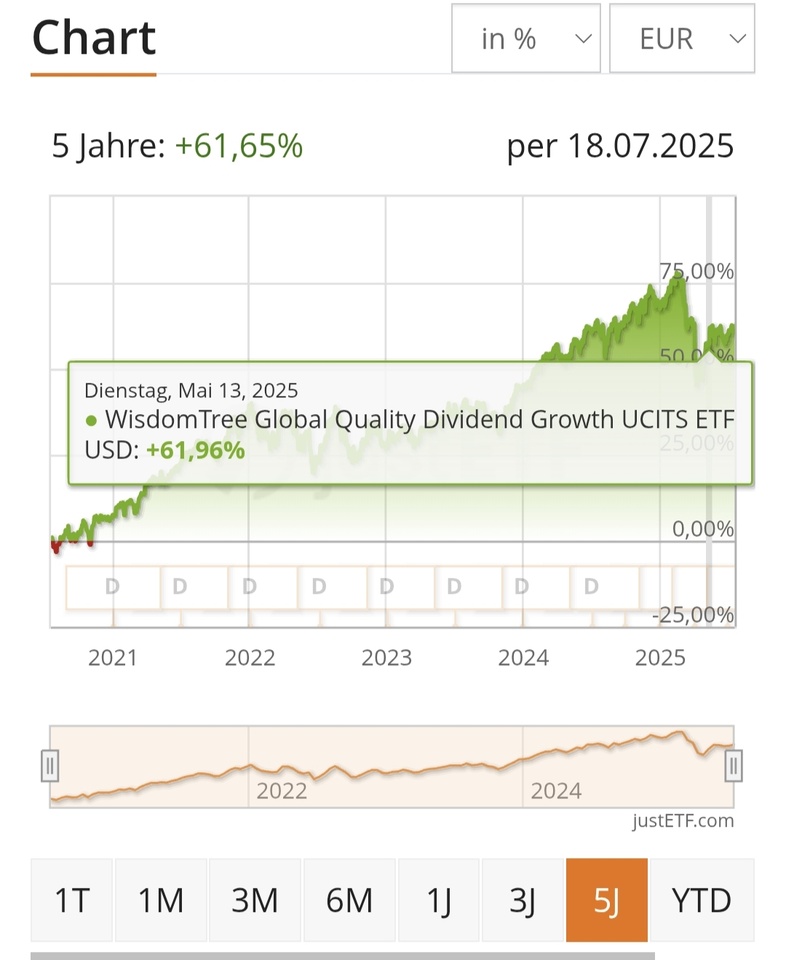October was the month of big decisions and consistent adherence to the plan! While the crypto market was still euphorically looking upwards, I think I recognized the signals: The bull market came to an end around October 21, For me it was time for an exit from this asset class. With the exception of a small holding of a few euros in $BTC (+0,21 %) as a souvenir, I am completely out of crypto. Everything was shifted to my crypto successor portfolio. Sure, there was a brief tingling sensation and I wondered whether I was getting out too early.
But there are plans precisely for scenarios like this. To conquer emotions that jeopardize profits and let discipline prevail. And how am I feeling now after the exit? Pure relief! Finally no longer sitting there hoping that things will rise to my desired level or stay there. I'll reveal in detail what happens next for me in the coming year.
At the same time, the half-year bonus was added to the portfolio, the dividend base was broadened and I was able to relax and let it all sink in while hiking in the autumn air. My portfolios continued to do their job. The cash flow is flowing. Time for a review of a month that shows that a strategy beats FOMO.
Overall performance
October brought another boost for me in some assets, while others consolidated somewhat. Perhaps this is already a sign that stocks are positioning themselves for the year-end rally? I am firmly convinced that the current shutdown in the US administration will not act as a brake here. My key performance indicators for my overall portfolio at a glance:
- TTWROR (month under review): +1,39% (previous month: +1.76%)
- TTWROR (since inception): +77,04%
- IZF (month under review): +17,65% (previous month: +9.64%)
- IZF (since inception): +10,94%
- Delta: +1,160.94€
- Absolute change: +€2,224.10
Performance & volume
$AVGO (+1,89 %) is still my largest single position, but is losing momentum this month. However, its distance to the other positions is large enough, no one in the portfolio can hold a candle to my +337% share. But $NFLX (-0,35 %) and $GOOGL (+1,6 %) and others are trying hard to get there. Alphabet is now in the top 5 by volume and performance. I like the company. With YouTube and Cloud Services, they have good cash cows that enhance traditional search. And this is now also being upgraded with Gemini integrated into search. And Nano Banana ... wow.
Google is not always the leader, but it is always catching up. The competition between the tech giants is a spectacle that I love to watch.
And yet I prefer to rely on the more stable industries. Even the $BAC (+0,68 %) and $WMT (-3,83 %) continue to cut a good figure. Boring, but still good businesses that generate income. That's what I want! These are really two sectors that I have become very fond of. Nevertheless, the red lantern once again goes to $TGT (-1,38 %) which continue to have a hard time. But I'm sticking with it and buying more. Because $TGT (-1,38 %) is systemically relevant and will not go to the dogs. They just have problems with theft and competition.
Size of individual share positions by volume in the overall portfolio:
Share (%) of the total portfolio and associated securities account:
$AVGO (+1,89 %) 3.14% (main share portfolio)
$NFLX (-0,35 %) 1.72% (main share portfolio)
$WMT (-3,83 %) 1.65% (main share portfolio)
$BAC (+0,68 %) 1.48% (main share portfolio)
$GOOGL (+1,6 %) 1.41% (main share portfolio)
Smallest individual share positions by volume in the overall portfolio:
Share (%) of the total portfolio and associated securities account:
$NOVO B (+8,45 %) 0.45% (main share portfolio)
$BATS (-0,15 %) : 0.50% (crypto follow-on portfolio)
$GIS (-3,51 %) 0.55% (main share portfolio)
$TGT (-1,38 %) 0.58% (main share portfolio)
$MDLZ (-0,5 %) 0.60% (main share portfolio)
Top-performing individual stocks
Shares with performance since initial purchase (%) and the respective portfolio:
$AVGO (+1,89 %) : +337% (main share portfolio)
$NFLX (-0,35 %) +151% (main share portfolio)
$GOOGL (+1,6 %) +99% (main share portfolio)
$WMT (-3,83 %) +77% (main share portfolio)
$BAC (+0,68 %) + 74% (main share portfolio)
Flop performer individual stocks
Shares with performance since initial purchase (%) and the respective portfolio:
$TGT (-1,38 %) : -35% (main share portfolio)
$GIS (-3,51 %) -34% (main share portfolio)
$NKE (+0,18 %) : -32% (main share portfolio)
$NOVO B (+8,45 %) -28% (main share portfolio)
$CPB (-3,05 %) : -27% (main share portfolio)
Asset allocation
Due to my crypto reallocation, the ETF share is increasing. My asset allocation is as follows:
ETFs: 41.5%
Equities: 58.4%
Crypto: less than 0.01%
P2P: less than 0.01%
Investments and subsequent purchases
I have invested the following amounts in savings plans:
Planned savings plan amount from the fixed net salary: €1,030
Planned savings plan amount from the fixed net salary, incl. reinvested dividends according to plan size: €1,140
Savings ratio of the savings plans to the fixed net salary: 49.75%
In addition, there were the following additional investments from returns, refunds, cashback, etc. as one-off savings plans/repurchases:
Subsequent purchases/one-off savings plans as cashback annuities from refunds: € 73.00
Subsequent purchases/one-off savings plans as a cashback annuity from bonuses: € 894.97
Subsequent purchases from other surpluses: €31.00
Automatically reinvested dividends by the broker: €2.76 (function is only activated for an old custody account, as I otherwise prefer to control the reinvestment myself)
Additional purchases from crypto sales: €1,604.86
Additional purchases were made in various custody accounts outside the regular savings plans:
Number of additional purchases: 9
124.97€ for $SPYD (-0,44 %)
770,00 $JEPQ (+0,29 %)
28.00€ for $JEGP (+0,16 %)
45,00€ for $GGRP (+0,32 %)
477,77€ for $DXSA (-0,22 %)
252,51€ for $EXX5 (-0,39 %)
270,99€ for $SHEL (+0,15 %)
102,97€ for $HSBA (-0,07 %)
445.58€ for $BATS (-0,15 %)
Passive income from dividends
My income from dividends amounted to € 148.90 (€ 81.32 in the same month last year). This corresponds to a change of +82.43% compared to the same month last year. The strong increase is due to the fact that my large Vanguard ETFs postponed the distribution to the reporting month. Further key data on the distributions follows:
Number of dividend payments: 26
Number of payment days: 10 days
Average dividend per payment: €5.73
average dividend per payment day: €14.89
The top three payers are:
$ISPA (+0,35 %)
$VHYL (+0,09 %)
$VWRL (+0,18 %)
My passive income from dividends (and some interest) mathematically covered 16.05% of my expenses in the month under review.
Crypto performance
My crypto portfolio is distorted by the sell-off and will not be calculated again until I get back in. That will now take quite a while. I got out later than I wanted to, but still made a good profit. Only the Oracle of Delphi knows whether I am right with my approach. My key figures:
Performance in the reporting period: -
Performance since inception: -
Proportion of holdings for which the tax holding period has expired: 100%.
Crypto share of the total portfolio: less than 0.001%
Now it's time for the same thing as last crypto winter. Learning and understanding. And the current crypto winter hasn't even started yet. However, I think that prices will fall less sharply than in previous cycles and that the decline will be more orderly due to institutional adaptation. That's a good thing right now, as it makes it easier to get back in.
Performance comparison: portfolio vs. benchmarks
A comparison of my portfolio with two important ETFs shows:
TTWROR (current month): +1,39%
$VWRL (+0,18 %) : +4,66%
$VUSA (+0,17 %) : +2,76%
I am lagging behind the ETFs. 🤷🏼♂️
Risk ratios
Here are my risk figures for the month under review:
Maximum drawdown: 1.94% (YTD: 17.17%)
Maximum drawdown duration: 13 days (YTD: 702 days)
Volatility: 2.51% (YTD: 28.02%)
Sharpe ratio: 7.03 (YTD: 0.39)
Semi-volatility: 1.69% (YTD: 20.82%)
A drawdown of only 1.94% in October? That's exactly how it should be. While the markets trended sideways to slightly upwards, my portfolio remained frighteningly boring. And in the best sense of the word. The volatility of 2.51 % and the semi-volatility of 1.69 % confirm that my crypto exit has increased the stability of my portfolio. No more wild swings, just solid growth. The Sharpe ratio of 7.03? Brutally good. Maybe Trump's China deal helped the markets, maybe it was just my perfect timing. No matter! The figures speak for themselves: strategy beats chaos.
Outlook
Thanks for reading, this time I want to keep the outlook deliberately short. I'm glad that you're honoring the several days of work in front of the computer in the evenings when others are chilling with Netflix with your lifetime. I don't have anything else for the miscellaneous category this time. If you want to know what else is on my mind, please refer to the August review. I'll have something to say about that next December, I think. Stay safe and sound!
👉 Would you like to see my review as an Instagram Carousel post?
Then follow me on Instagram:
📲 In addition to the portfolio and budget review, there are currently three posts a week: @frugalfreisein
Please pay close attention to the spelling, unfortunately there are too many fake and phishing accounts on social media. I have also been "copied" several times now.
👉 How was your month in the portfolio? Do you have any tops and flops to report?
Leave your thoughts in the comments!


















